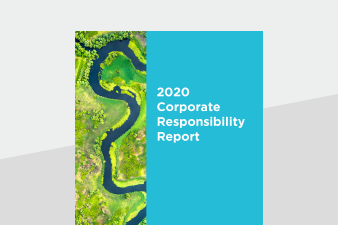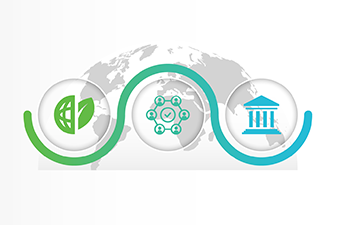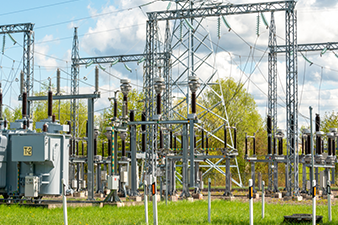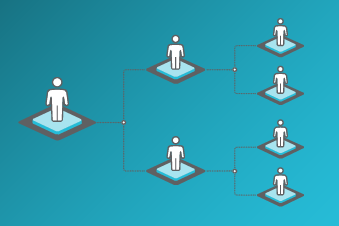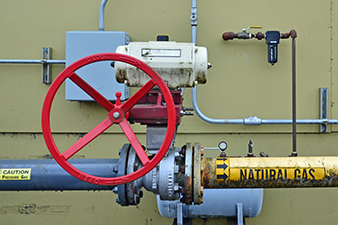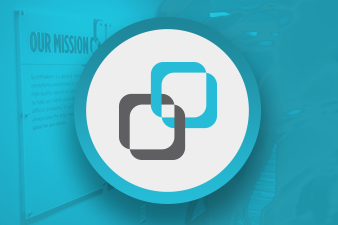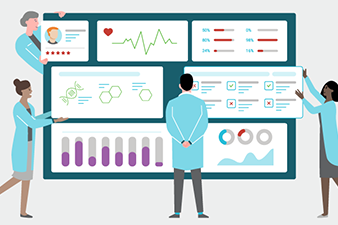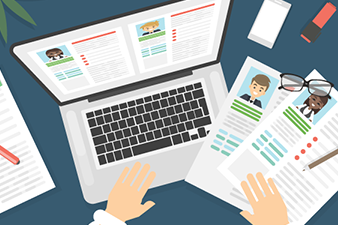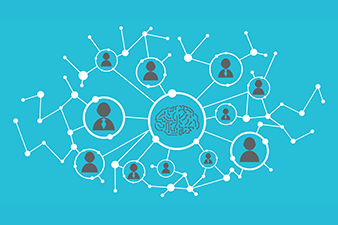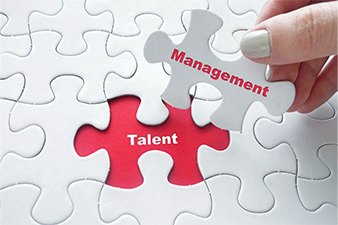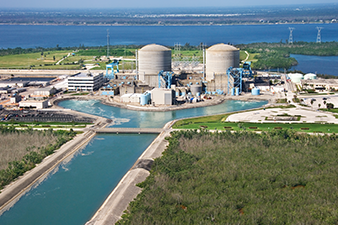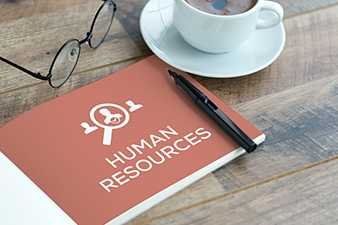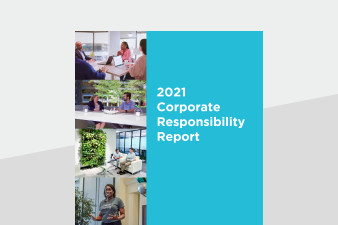
Eighteen months after COVID-19 forced workforce disruptions to most utilities, leaders are facing new challenges that may last even longer. The assumption was that once vaccination rates climbed there would be a return to the office and a return to normal. The pandemic would be behind us, and workers would return safely to their pre-COVID workplace.
However, companies today are facing an environment that few could have imagined. COVID cases are surging in many areas, powered by the Delta variant, which accounts for more than 90% of new cases. Employers are navigating decisions on mask and vaccine mandates. Remote work environments, once considered to be a temporary “workaround,” may now be considered more of a consistent part of the workplace structure.
In the midst of these external factors, leaders are facing other workforce challenges. Companies are experiencing an increase in attrition and retirements. Competition for top talent has surged from companies that are quickly pivoting to offer flexibility and remote employment options. Worker concerns related to safety and protection are, justifiably, elevated.
As utility leaders take action to address immediate and near-term needs, attention is also needed on longer-term workforce strategies. Examples of key-planning questions include:
- Are we prepared for increased attrition and retirements in our most critical hard-to-fill positions?
- Do we need to change our strategies around flexible work arrangements in order to attract top talent?
- Have we stress-tested our workforce plans to respond to compound events (e.g., pandemic, major storm, or cyberattack)?
- Should we assess our use of temporary, part-time, and full-time employees and contractors to balance flexibility (e.g., gig economy workers) with traditional full-time hires?
- How do we ensure our workforce remains safe, as we adjust to welcome workers and contractors back to offices and work sites?
- How do we ensure a high-performing and inclusive environment, as we consider moving roles to be more remote or hybrid?
- What will employees’ expectations be as COVID restrictions lift? What do we need to consider as it relates to the work environment, work conditions, technology, and flexible policies?
Answering these questions can be daunting but using a structured approach can help. Scenario planning is a tool that is often used to develop corporate strategies under a variety of potential futures. This approach can be adapted to focus on planning for important aspects of workforce strategy.
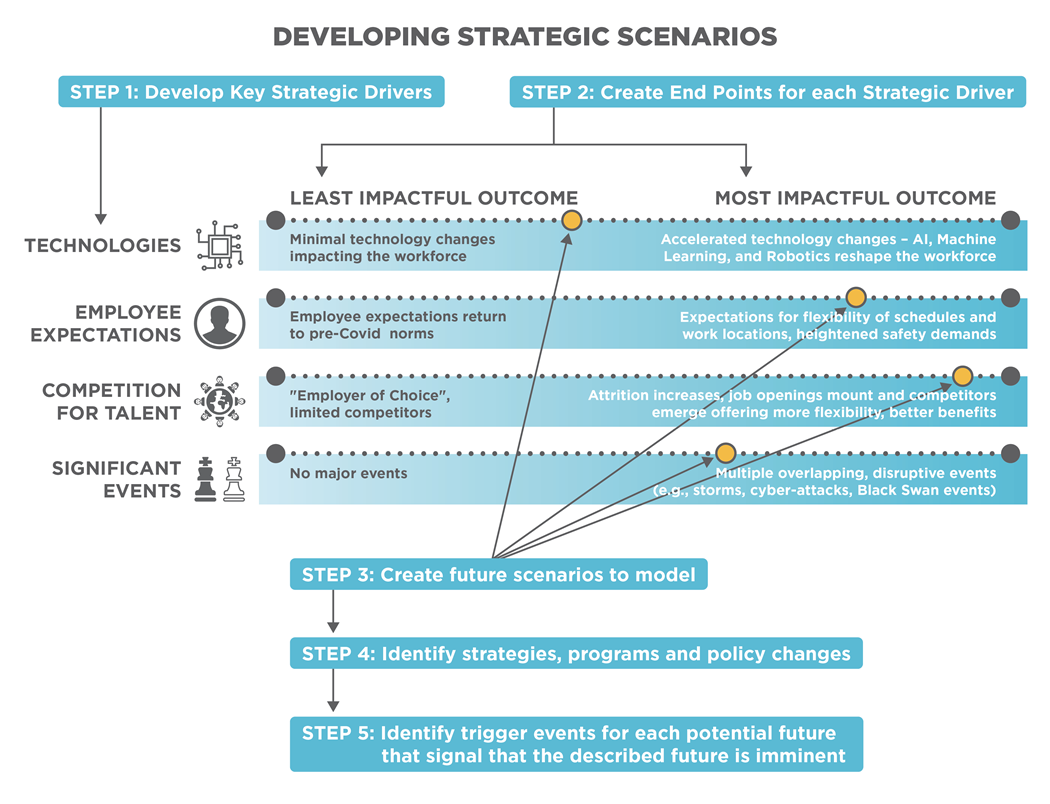
The five steps to scenario-based workforce strategy are:
- Develop key strategic drivers that will impact workforce strategy.
Identify the key factors driving strategy that could potentially affect your workforce as part of the “new normal.” These factors might include:
- Economic conditions
- Technology requirements
- Employee expectations (e.g., the safety of work conditions, work location, and schedule flexibility — “we’ve done it for months”)
- Significant events (e.g., pandemic re-emergence, major storm, cyber-attack)
As an example, let’s evaluate a potential strategic driver for this new normal: employee expectations (e.g., workplace safety, remote work policies and programs, time off policies).
- Create endpoints for each of the strategic drivers.
For each strategic factor, determine and describe the two ends of the spectrum for future situations—the least risky outcome (e.g., workforce needs remain the same) and the most extreme outcome (e.g., most significant changes require a full reboot of workforce strategy).
Continuing with our example of employee expectations, let’s now define the two endpoints:
- Least Impactful – employee expectations are unchanged through the COVID-19 pandemic
- Most Impactful – Extreme measures required for ensuring employees feel safe and productive and to meet employee needs and desires (e.g., top talent expects protocols and policies around workplace safety, work schedules, and work locations allow for flexibility and worker preference, and robust technologies are needed to support ongoing remote work).
3. Create a set of future scenarios to model.
Looking across the strategic drivers and the potential spectrum of outcomes, establish a set of future scenarios that might emerge in the future. Usually, these potential scenarios will fall somewhere along the spectrum of future situations. As a group exercise, you may even “vote” on where along the spectrum your future is likely to be (e.g., leaning toward the lowest-risk end, leaning toward the extreme end, or perhaps, somewhere in the middle). Scenarios may reflect the worst-case, but less likely future for a particular driver, or they may represent a more likely, but less impactful future. In more advanced-planning exercises, scenarios are built across multiple drivers, but for initial planning, we recommend that teams focus on scenarios that are impacted by a single driver.
In our example, a particular scenario might be one where employees’ expectations are at the upper end of the spectrum. Unions and individual employees and applicants are expecting changes to the work environment, flexible work policies, aggressive monitoring of employee wellness (e.g., vaccine attestations with alternative testing/monitoring).
- Identify strategies, programs, and policy changes.
In this step, create strategies that would address each of the issues, challenges, or opportunities presented for each scenario. In developing these strategies, consider “no regrets” actions that will benefit any scenario.
For our example, strategies might include creating a tiered remote work policy that provides varying levels of flexibility when external events dictate or creating a crowd-sourced tracker of employee wellness that would alert management when employee concerns about workplace safety are escalating. A no-regrets action may be enhancing work tools and technology that will be beneficial in either a low-risk or extreme scenario.
- Identify trigger events for each potential future that signal the described future is imminent.
These triggers will serve as the “canary in the coal mine” that the strategies or policy changes identified for that future should be implemented.
Our example scenario might have triggered events, such as a rise in employee complaints or grievances, an increase in employee regrettable departures (e.g., looking for better conditions or more flexibility), or candidate feedback around workplace policies from recruiting events.
This structured approach works well as a group session attended by leaders representing delivery operations, generation, workforce planning, and HR business partners. By focusing on possible scenarios, participants anticipate the challenges, opportunities, and business decisions that accompany each potential future and document actions that mitigate negative impacts or take advantage of opportunities.
The emergence from the initial COVID-19 restrictions and variant waves have tested the preparedness of utilities and, in some cases, created renewed awareness of the value of workforce strategy. By adapting proven scenario planning techniques to focus on workforce needs, utilities can improve their ability to respond quickly and confidently to future events.
ScottMadden has guided many leaders through this strategic planning process, and we can help you and your team think through workforce strategies and other challenges presented by COVID-19. We are all working through this one day at a time. Let us know if we can help you!


